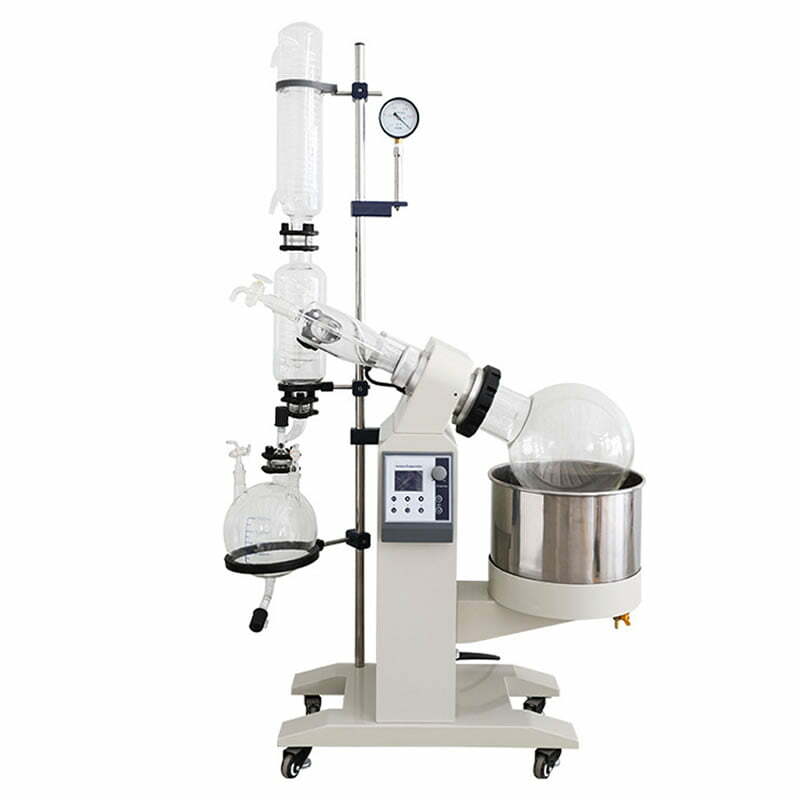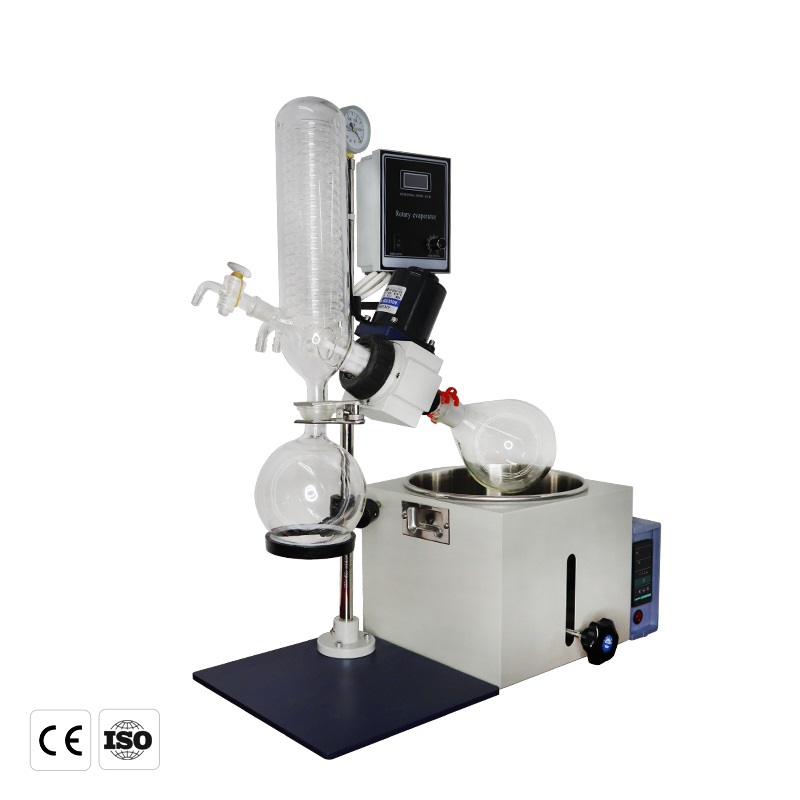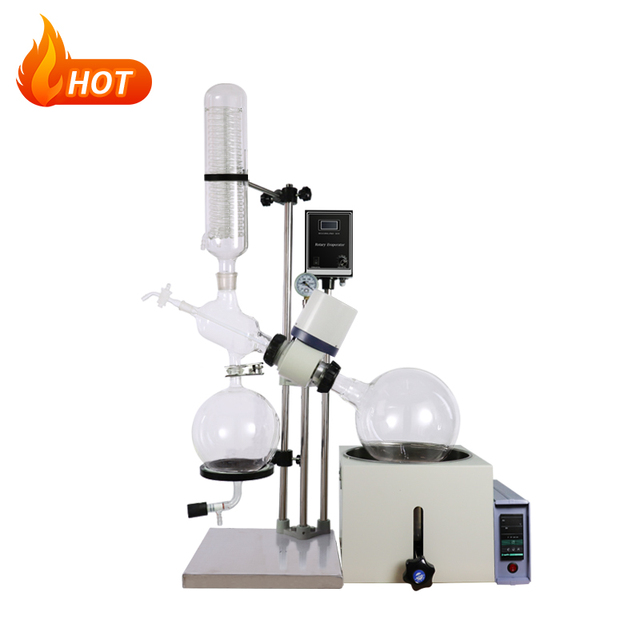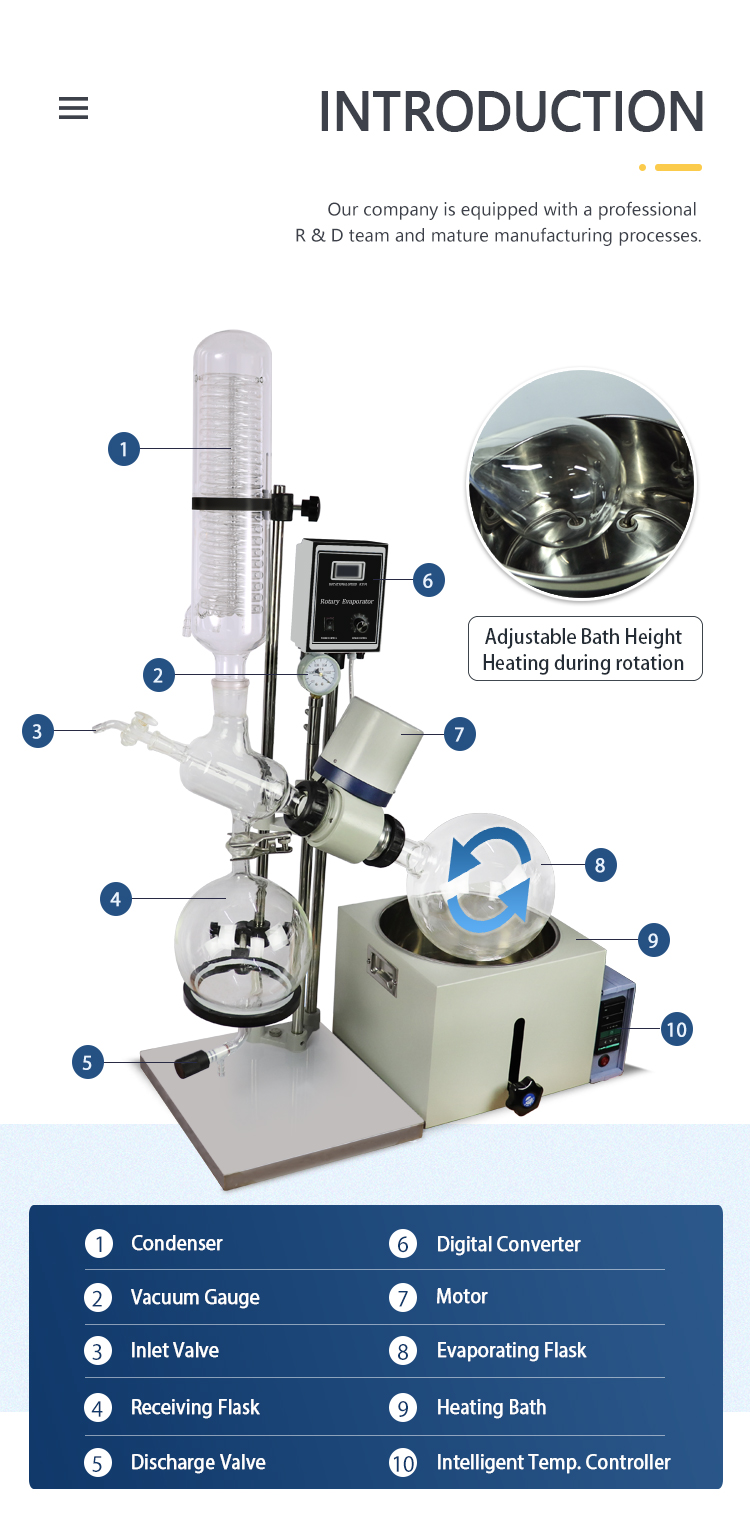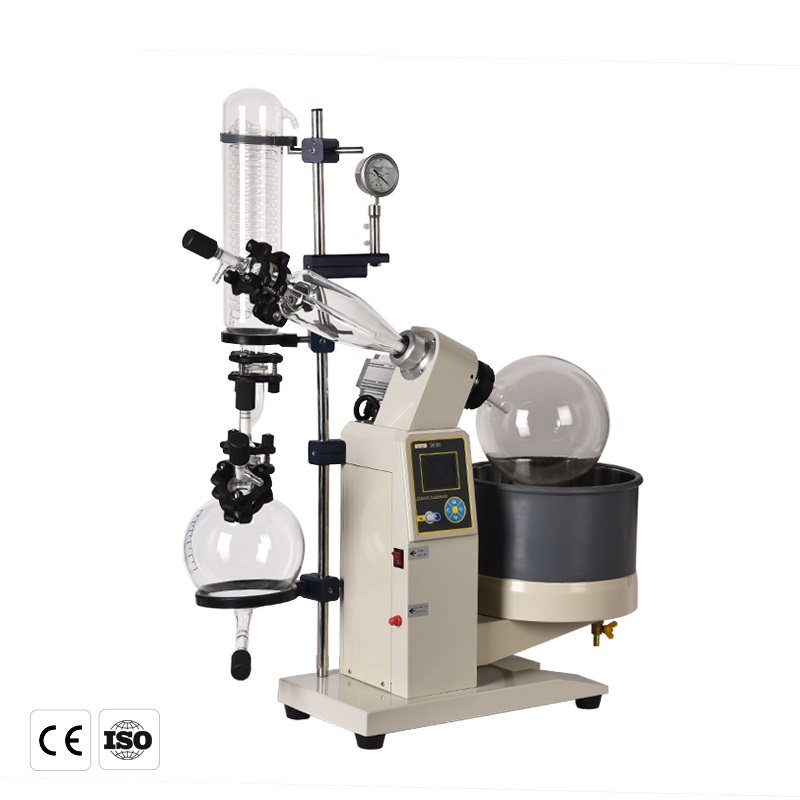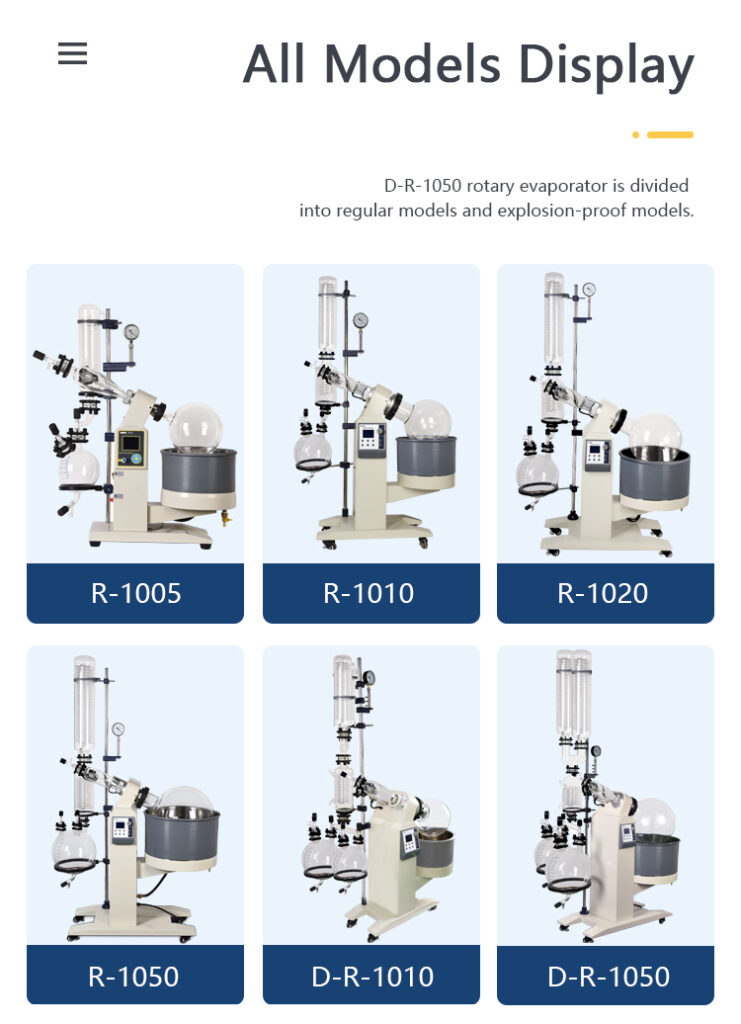A rotary evaporator (rotovap) is a device commonly used in chemical laboratories for the efficient and gentle removal of the volatile solvents from samples by evaporation. They are found in almost every organic laboratory. The rotation flask rotates and shapes a thin film in negative pressure condition by heating; it evaporates; and then the vapor is condensed, liquefied, and recollected for separation.
A typical thin film evaporator has a water bath that can be heated in either a metal container or crystallization dish. This keeps the solvent from freezing during the evaporation process. The solvent is removed under vacuum, is trapped by a condenser, and is collected for easy reuse or disposal.
We can provide the whole solution for a rotary evaporator, including the circulating chiller and vacuum pump.
2L 3L 5L Desktop rotary evaporator with hand lift and oil bath
Main Fratures
Easy-to-operate hand lift on the heating bath .
Volume options: 0.25 – 5L .
Available in both 110V and 220V.
Temperature range: room temperature to 180C .
4 different condenser options: vertical coil, diagonal coil, cold trap, reflux.
High quality borosilicate glass 3.3 with excellent physical and chemical properties for glass parts.
SUS 304 stainless steel oil/water bath.
Available models
RE-201D
RE-301
RE-501
1L 2L 3L 5L Desktop rotary evaporator with motor lift and water/oil bath
Chemical-Lab-Vacuum-rotary-evaporator
Main Fratures
Digital PID temperature and rotation speed control
All PTFE valves for improved lifespan and chemical resistance
State-of-the-art design with single controller panel and motor lift
Best value choice for lab rotary evaporation.
Volume options: 0.25 – 5L.
Available in both 110V and 220V .
Heating bath options: water (99C) or oil (180C) .
4 different condenser options: vertical coil, diagonal coil, cold trap, reflux
Available models
RE-2000A
RE-2000B
RE-2000E
10L 20L 50L Industrial rotary evaporator with hand lift and water/oil bath
Main Fratures
Easy-to-operate and stable hand lift on the heating bath.
Volume options: 10L, 20L and 50L.
Temperature range: room temperature to 180C .
Available in both 1-phase or 3-phase, Euporean or North American standards.
Available models
RE-1002
RE-2002
RE-5002
10L 20L 50L Explosion proof rotary evaporator with hand lift and water/oil bath
Industrial-Rotary-Vacuum-Evaporator-Explosion
Main Fratures
Explosion proof rated to Exd IIB T4 (equivalent to Class I Division 1 Group C T4 .
Cost effective choice for large scale rotary evaporation.
Fully customizable condenser structure .
Volume options: 10L, 20L and 50L .
Temperature range: room temperature to 180C .
Easy-to-operate and stable hand lift on the heating bath .
Available in both 1-phase or 3-phase, Euporean or North American standards.
Available models
EXRE-1002
EXRE-2002
EXRE-5002
10L 20L 50L Industrial rotary evaporator with motor lift and water/oil bath
Essential-Oil-Distillation-Vacuum-Chiller-Rotary
Main Fratures
Specialized motor with extremely compact, intermeshed worm and worm gear provides precise driving for very quiet, vibration-free operation.
Downward-condensing vacuum connection design ensures safe vacuum operation
Modular design (individual rotary and water bath modules) for extremely easy maintenance and easy future upgrades
Easy, straight-forward and visual operation with digital speed and temperature display
PID temperature controller ensures accurate temperature
1-way check valve automatically turns off when draining the receiving flask. The pressure inside evaporator won’t be changed during draining
Available models
R-1005
R-1010
R-1020
R-1050
Structure of Rotary Evaporator
The main components of a rotary evaporator are:
A motor unit that rotates the evaporation flask or vial containing the user’s sample.
A vapor duct that is the axis for sample rotation, and is a vacuum-tight conduit for the vapor being drawn off the sample.
A vacuum system, to substantially reduce the pressure within the evaporator system.
A heated fluid bath (generally water) to heat the sample.
A condenser with either a coil passing coolant, or a “cold finger” into which coolant mixtures such as dry ice and acetone are placed.
A condensate-collecting flask at the bottom of the condenser, to catch the distilling solvent after it re-condenses.
A mechanical or motorized mechanism to quickly lift the evaporation flask from the heating bath.
Structure of Rotary Evaporator
The Principles of Rotary Evaporator
The rotary evaporator principle is that the boiling points of liquids reduces on decreasing their pressure, allowing solvents to be vaporized at much lower temperatures than their boiling points at normal pressure. Vacuum system is necessary to accomplish whole procedure, select a suitable vacuum pump for your rotovap will efficiently improved the evaporation efficiency. A condenser at the other end converts the gas back to liquid, which requires lowered temperatures. To achieve cooling effect, dry ice, water, or liquid nitrogen always been used. The evaporation vessel constantly rotates. This tactic aims to increase the surface area of the liquids. The centrifugal force keeps the liquid sticking to the inner surface of the vessel, exposing a larger surface area and causing faster evaporation.
How a Rotary Evaporator works?
The main components of a rotary evaporator or “rotovap” include a motor unit, a vapor duct, a vacuum system, a heated fluid bath, a condenser with either a coil passing coolant, or a “cold finger, a condensate-collecting flask and a mechanical or motorized mechanism. In a rotary evaporator, the motor rotates the evaporation flask or vial containing the user’s sample. Vapor duct is the axis for sample rotation, and is a vacuum-tight conduit for the vapor being drawn off the sample. The vacuum system substantially reduces the pressure within the evaporator system. The vacuum system can be as simple as a water aspirator with a trap immersed in a cold bath (for non-toxic solvents), or as complex as a regulated mechanical vacuum pump with refrigerated trap. A heated fluid bath, which is usually water, heats the sample. The condenser used in rotary evaporator can be simple or complex, depending upon the goals of the evaporation, and any propensities the dissolved compounds might give to the mixture. The condensate-collecting flask is located at the bottom of the condenser and it catches the distilling solvent after it re-condenses. The mechanical or motorized mechanism quickly lifts the evaporation flask from the heating bath.
General rules for usage of rotary evaporators
1. The solvent collection flask of the unit should always be emptied prior use to prevent accidentally mixing of incompatible chemicals. SAFETY FIRST!
2. The flask with the solution is placed on the rotary evaporator. The use of a bump trap prevents the solution from accidentally splashing into the condenser (and being contaminated). It is highly advisable to start with a clean bump bulb in case something bumps over after all! This would allow the experimenter to recover the solution or solid.
rotory-evaporator
3. A metal or Keck clip is used to secure the flask and the bump trap. The green one shown below fits 24/40 ground glass joints. Similar blue clips fit 19/22 joints and the yellow ones fit 14/20 joints, which will most likely used in the lab. If you break the bump trap, you will have to pay for it!
4. The dial on the motor is used for speed control of the flask rotation. A typical rotavap uses a variable speed sparkless induction motor that spins at 0-220 rpm and provides high constant torque. A good setting here is 7-8.
5. The aspirator vacuum is turned on. On most models, the vacuum on/off control is managed by turning a stopcock at the top of the condenser (left side of the above diagram). This stopcock is later also used to vent the setup after the solvent is removed.
6. The flask is lowered into the water bath (or the water bath is raised to immerse the flask in the warm water. (On most models, a convenient handle (with height locking mechanism) moves the entire condenser/motor/flask assembly up and down. Often the tilt of the condenser assembly can also be adjusted. The water bath temperature should not exceed the boiling point of the solvent!! For small amounts of common solvents the bath heater is not needed.
7. The solvent should start collecting on the condenser and drip into the receiving flask. Some solvents (such as diethyl ether or dichloromethane) are so volatile that they will also evaporate from the receiving flask and be discharged down the drain. To prevent this, a cooling bath on the receiver or (on some models) use a dry-ice condenser can be used. In addition, an additional trap (with dry-ice or liquid nitrogen) can be placed between the vacuum source and the condenser unit. This is particularly important of a membrane pump is used as vacuum source.
8. Once all the solvent evaporated (or whatever is desired at this point), the vacuum is released,. The flask is raised out of the water bath and the spinning is discontinued.
9. The bump trap has to be cleaned and the receiving flask is emptied upon completion of the evaporation.
